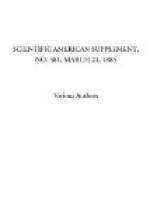At the conclusion of my lecture before the Institute at Leeds, on “Combustion and the Utilization of Waste Heat,” Mr. Kitson, the Chairman, remarked that if he were a dreamer of dreams, he might look forward to the time when he would be growing cucumbers with the waste heat of his iron furnaces. Many wilder dreams than this have come true in the science of engineering; and the realization has brought honor and fortune to the dreamers, as you must all know. The history of engineering is full of the realization of “dreams,” which have been denounced as absurdities by some of the best living authorities.
* * * * *
THE GAS METER
The gas meter was invented by Clegg in 1816. Since that epoch no essential modification has been made of its structure. Fig. 1 shows the principle of the apparatus, mnpq is a drum movable around a horizontal axis. This is divided by partitions of peculiar form into four vessels of equal capacity, and dips into a closed water reservoir, RR’. A tube, t, near the axis, and the orifice of which is above the level of the water, leads the gas to be measured. This latter enters under the partition, l’m, of one of the buckets, and exerts an upward thrust upon it that communicates a rotary motion to the drum. The bucket, l’mi, closed hydraulically, rises and fills with gas until the following one comes to occupy its place above the entrance tube and fills with gas in turn. Simultaneously, as soon as the edge of each bucket emerges at e, the gas flows out through the opening that the water ceases to close, and escapes from the reservoir through the exit aperture, S. The gas, in continuing to traverse the system, is thus filling one bucket while the preceding one is losing its contents; so that, if the capacity of each bucket is known, the volumes of the gas discharged will likewise be known when the number of revolutions made by the drum shall have been counted. The addition of a revolution counter to the drum, then, will solve the problem.
[Illustration: THE GAS METER.]




